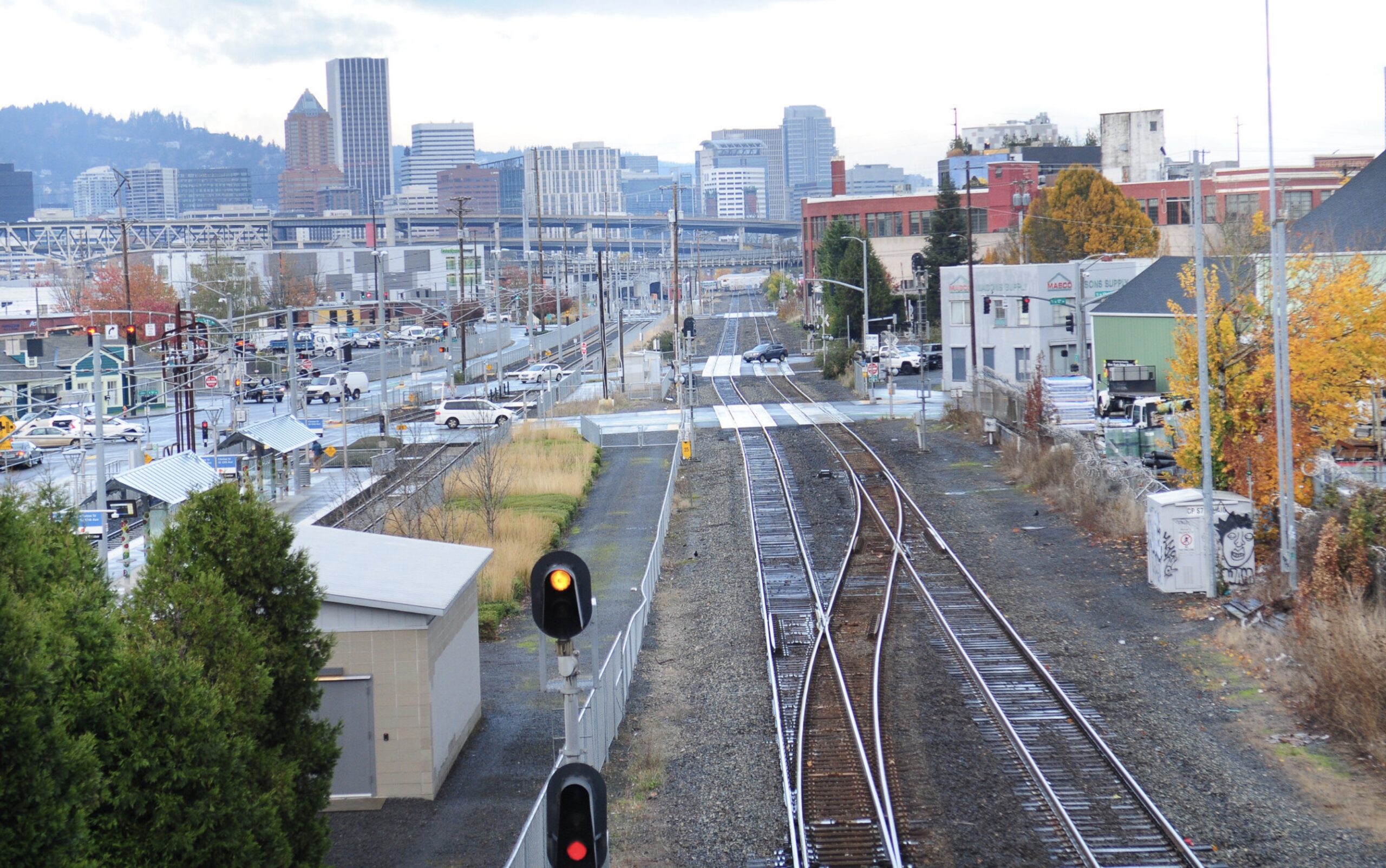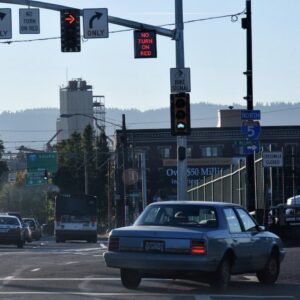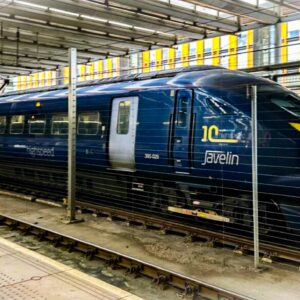
“Union Pacific appears congenitally unable to manage trains in Brooklyn Yard without disrupting neighborhoods and transit throughout the Metro area.”
Trains were all the rage last week, and I’m beginning to think that good comments travel in packs. Readers’ response to Taylor Griggs’s article, City will seek federal grant to study southeast train crossing delays, was strikingly knowledgeable. Portland is lucky to have such well-informed residents.
Out of the crowd, Ruth’s comment stood out because it was a strong and simple tale of the disruption the trains cause her—from someone who has spent hours waiting for trains to pass. The comment’s power comes from the contrast between her calm description of the problem and how maddening it must be to experience it.
What’s the lesson? Writing is not about merely expressing your emotion, it’s about leading your reader to feel it.
Here’s what Ruth wrote:
I’ve e-mailed TriMet twice on this very topic. Both times before plans were finalized. I cross these tracks (pedestrian) twice a day, every day I work. I call if the train is not moving. My phone shows I call between two and eight times a month. This on a four day work week basis, so eight crossings a week usually.
My record wait (after MAX went in & before the return of a pedestrian overpass) was one hour and 50 minutes. And traffic was already stopped & backed up in front of my workplace more than three blocks north of the crossing when I left work.
It is not so much the trains moving through that are a problem, though UP has pretty much doubled the length of the longest making even a moving train a non-trivial wait. It is the ones that park on the tracks. UP is using SE Portland and likely NE, NW, N PDX (and probably Milwaukie) as an extension of Brooklyn Yard.
UP logistics appears congenitally unable to manage trains in Brooklyn Yard without disrupting neighborhoods and transit throughout the Metro area. Perhaps it is time for UP to dismantle Brooklyn (better: turn it over to the Rail Historical Society) and move switching out somewhere into empty countryside. There, they can park the trains for extended periods without blocking multiple crossings & polluting multiple neighborhoods.
Thank you Ruth! You can read Ruth’s comment, and the whole informative thread, under the original article.






Thanks for reading.
BikePortland has served this community with independent community journalism since 2005. We rely on subscriptions from readers like you to survive. Your financial support is vital in keeping this valuable resource alive and well.
Please subscribe today to strengthen and expand our work.
I don’t get why the city and state haven’t bothered to consider grade seperating the rail line through central Portland. It’s good for the city, and it’s also a prerequisite for fast and frequent passenger service south through the rest of the Willamette Valley.
Well, UP owns the tracks and right of way. For probably the last 100 years or so. Freight trains don’t run on schedules, the go when they’re ready. It’s like moving next door to an airport that been operating for years, and complaining about the noise.
That’s an attitude I see often–“If you don’t like the impacts (noise, glare, traffic, crowds, smell…) you shouldn’t have moved next to a (park, street, airport, restaurant, school…).
But it works two ways. If UP didn’t want people to push back against their blocking streets used by thousands of people, they shouldn’t have put their railroad yard so close to a growing city.
But both views are really beside the point. The relevant issue is the disruption to people being able to use the streets, as described so well in Ruth’s comment. It’s legitimate for people to expect that that be fixed.
The UP was founded in 1862 and it or it’s predecessor railroad was there long before the city. The railroad didn’t “put their railroad yard so close to a growing city,” the city grew around the railroad.
Lots of people on this site complain that trucks should not be used for hauling freight that can better be carried by rail, but when trains interfere with us, we complain about that, too. Can’t win.
Airships.
I guess UP was as shocked as anyone that a city appeared here then.
Thinking trains have some advantages over trucks for some freight hauling doesn’t mean people should accept all negative impacts of freight trains. And ironically, some solutions to reduce impacts (say paying UP to limit street blockages of certain durations to certain times of day) might be welcomed by UP. Wanting to reduce disruptions is not the same as being anti-train.
Actually they put the rail line there specifically because it was the most important city in Oregon and it was where they could make the most money
The City wanted the railroad and the city was important because of shipping and harbor. The two things go together and can’t be seperated.
Not to mention a BIG reason why Portland grew between the 1860s and the 1940s was the railroads and shipping. The port and Swan Island are intimately tied to the railroad. The lumber industry and the farm products and just about every other industry in the region was dependent on the railroads.
I’m on board with cycling, and with walkable neighborhods, and I agree the brooklyn tracks are a huge problem for the city,
It is just historically ignorant to fault the railroads for creating the problem. If anything, the city of Portland should have never put a neighborhood and and bunch of transportation infrastructure over the top of the railroad’s main lines.
Don’t get me wrong, I’m all for fixing it. I just can’t help pointiing out an historically uninformed statement.
Thank you Paul. I love the granaries and industry and agriculture that give our city its gritty, working port aesthetic. It’s part of what makes Portland Portland.
That’s all rapidly disappearing, even in the immediate area we are discussing. Remember the big Land of Lakes grain silos and mill on 8th? Torn down a decade ago, The Dairy Cooperative Assoc building (warehouse and old mill) has been converted into small creative spaces. It was a working mill until mid-twentieth century. And how much longer will Standard Electric Motor be there? The Ford Building? creative spaces. I can go on.
The old landowners are selling their property, the MAX line accelerated that.
It’s a bumpy transition.
And it can be fixed!
I am quite sure UP would accept a sufficiently large government bribe to relocate out of Portland. Their trains will still move through, but the most disruptive activity (including all the associated trucking) would occur elsewhere.
How much of your money is it worth?
When you consider the cost of the disruptions to thousands of people and hundreds of properties, and the costs of some mitigations (just several tunnels or overpasses could cost $100 million) it seems it could be worth hundreds of millions of dollars to reduce the disruptions. Plus, like you said, it doesn’t have to be all or nothing.
*** Moderator: deleted first paragraph. Please try to make your points without broad insults aimed at neighborhoods. ***
Secondly, a city can’t grow w/o trains, trucks, ships, planes bring in materials & goods. I mean it could, but at a much slower pace and scale, but would good Capitalist wants that?!?!?!
But I definitely support studying the problem, b’cuz it is a problem but I suspect the railroad companies won’t be interested in making any changes b’cuz as Warren Buffet said “They’ve spent decades in maximizing efficiency to maximize profits”
In other words, they haven’t changed to adapt to a changing city and society.
Also, railroad workers are currently understaffed, overworked, underpaid and it’s not a job young people are flocking to. Also, POTUS just blocked a railroad worker strike.
FWIW, my bio father was a railroad worker.
No Jim, it’s not anything like that.
I spent a few years working in the area a little over a decade ago–outside. I used to stop and watch the occasional train go by (and plug my ears, they are loud!). The train didn’t take very long to pass, I thought it was sort of cool.
What’s changed, as Ruth points out, is the length of the trains. Two weeks ago I got stuck on 11th waiting to cross south to Powell. The train slowed down, then it stopped, then it reversed, then it stopped, then it pulled forward again…imagine about 10 minutes between each of these moves.
After about, 20, 30 minutes all the backed up cars put it in reverse and tried to u-turn back onto Division … what a mess.
(I also spent a few years working in the central east side, the trains mess with that area too.)
So it’s really not a problem of an individual complaining neighbor, but rather disruption of the city’s surface streets.
Being a one time UP engineer, it’s just what said.
“Well, UP owns the tracks and right of way.”
UP clearly has substantial usage rights on the right of way, but according to portlandmaps.com, it doesn’t own the right of way beyond the Brooklyn Yard itself.
Apart from the conversation about whether UP is being a jerk or whether their federally-subsidized construction in 1862 allows them to blithely disrupt city life and health until the heat death of the universe, can we take a moment and ask TriMet what the hell they’re doing?
They already ran one route (70) over the tracks, and they know how disruptive the UP trains are, and how they’re forced to detour constantly, often missing multiple stops and giving no notice to those waiting.
So now they have a shiny new “BRT” system in the FX. And where do they decide to run it? Across the damn train tracks. So you might save 10 minutes riding the FX compared to the old #2. Or you might be 20 minutes late. Who knows!
(To clarify: The FX could have easily run across the Hawthorne Bridge, as the 2 does. Or it could have run concurrently with the 2, instead of replacing it, and shifted down to Powell at Cesar Chavez, 26th or 21st. Instead they killed the 2, modified the 10 to pick up the slack, and planted their bendy BRT buses at impassible railroad crossings.)
Re: FX 2. It’s worth pointing out that the original plan was to run on outer division, then switch over to inner powell at 82nd. It was found during planning that that trip would’ve taken longer on average then staying on division.
It does come with two caveats: 1) UP has changed their operations since planning started and 2) 82nd was still owned by ODOT at the time, and they were much less willing to prioritize the movement of people at the expense of cars.
I was in more than one public meeting where TriMet was told that the UP was changing their operations and that blockages would become longer and more frequent. Which they have.
TriMet chose to ignore that information, but it was not kept secret from them.
I don’t know how long ago it was decided to transfer 82nd to PBOT, but I have known about it for a while, and I only know what everybody else who is listening knows. TriMet probably knew about it earlier than I did.
Just like our highway system, our train system has expanded upon a 100-to 150-year old conduit through an urban landscape with ever-increasing negative impacts upon those who live in that landscape. It is like a slowly growing disease – not noticeable short-term, but deadly in the long term. High time to stop the disease (increasing car and train traffic). High time to start decreasing car and train traffic in urban areas. Maybe the starting point is to recognize that they simply do not belong in a place for people. Lisa’s article does a great job of illuminating this reality.
And how do you expect any goods to get here without trains? We can’t just ship everything over waterways, because the continental divide exists. And we’re certainly not going to be shipping everything by plane.
The issue here is that Portland just planned exceedingly poorly by not grade separating the roads and paths from the rail line, not that trains come to the area.
I did not imply that we do not need trains, or highways. Only that they were not designed and built compatible with the urban environment – as Lisa makes clear in her article. It is absurd to think that you could suddenly get rid of them, but not absurd to start a process whereby someday (it might take 100 years) to make them less negative. As it stands, we simply increase traffic on both train tracks and highways with little serious consideration of the long-term impacts and without a long-term plan to mitigate those impacts. Just because Portland planned grade separation poorly does not mean they cannot plan a fix.
“they were not designed and built compatible with the urban environment”
Or, more accurately, the urban environment was not designed and built to be compatible with the pre-existing railroads.
“with ever-increasing negative impacts upon those who live in that landscape. It is like a slowly growing disease”
By that, I presume you mean providing jobs and industry that allowed Portland to grow into the city that it did.
Given the vastly reduced energy required to transport freight by rail compared to truck or air, I would like to see rail traffic increased.
Portland could look at what LA did in the late 90’s with the Alameda Corridor. They took the main train line coming from the port and put it into a trench. That ended up grade separating scores of intersections.
https://en.wikipedia.org/wiki/Alameda_Corridor
Infrastructure like the Alameda Corridor tends to work best in an environment where there is some semblance of law and order.
https://www.mercurynews.com/2022/01/17/thieves-raiding-rail-cargo-containers-in-los-angeles-2/
There’s got to be a way around a train that takes less than 1 hr, 50 mins. Not to be mean, but c’mon let’s be real here.
I used to run into these long trains sitting on the tracks for long periods of time when I was bicycle courier and it’s definitely frustrating, especially given the frequency of them in recent months as the supply chain backlog started moving again.
Also, railroad workers are having a difficult time right now. They’re understaffed, overworked, underpaid and I imagine there aren’t many young folks lining up outside the door to apply for a job.
Not too mention that POTUS just restricted them from striking. My biological father was a railroad worker.
The problem is that when you get blocked by a train, there’s no way to know how long the wait will be. It might be five minutes, or an hour. If you’re stuck in a car in traffic, you might not be able to turn around and leave readily even if you want to. You also can’t tell how long a train is unless you can get right up to it, and even if you can, you can’t know when it’s going to start moving if it’s stopped.
I agree the workers you see aren’t the issue.
Ruth was on foot, and stated that the ped bridge was closed. If you knew the train was going to be stopped for an hour 50 minutes, sure, maybe you could find a faster way. But no one tells you how long it’s going to sit there, parked.
“There’s got to be a way around a train that takes less than 1 hr, 50 mins.”
There is a good alternate route that utilizes the MLK viaduct, which is much shorter than the common detour of using SE 21st. The problem is it is a bit tricky to find if you don’t know how all the streets are hooked together.
I wish PBOT would highlight this route and direct drivers towards it when the crossing was blocked.
It is less good for cyclists, but we have the Gideon bridge.
The law against railroad workers from stringing goes back to WWII. The Taft Hartley Act. When I was an engineer, we were all set to strike against UP, and the act was invoked.